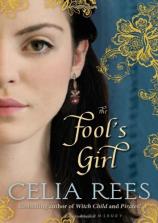The Fool's Girl
Review
The Fool's Girl
Twelfth Night was the first Shakespeare play I ever saw, and it remains my very favorite. I was in seventh grade and had been nervous about my own capacity to understand Shakespeare’s language. But as soon as the local university production of the comedy began, I was instantly hooked by the romance, the humor, the mistaken identities --- and, yes, by the language, too. The quick-witted Viola, the pompous Malvolio with his ridiculous yellow stockings, the boisterous Sir Toby Belch, and the surprisingly complicated Fool, Feste, all combined to make me fall in love with the Bard.
And apparently I’m not alone in my affection for Twelfth Night. Popular author Celia Rees has used the play as the inspiration for her new novel, THE FOOL’S GIRL, providing in her typically detailed, well-researched style both a sequel of sorts to the play and a dramatic explanation of how and why Shakespeare chose to dramatize this story.
Short version of Shakespeare’s play: Shipwreck victim Viola washes ashore, disguises herself as a boy to gain entry to the court of Duke Orsino, who pines for the countess Olivia even as Viola secretly longs for Orsino himself. When he sends the disguised Viola to plight his troth, Olivia falls for the young messenger instead. Much confusion ensues, but ultimately Orsino and Viola are wed, as are Olivia and Viola’s long-lost twin brother, Sebastian.
In Rees’s novel, Illyria, where Twelfth Night is set, is a real place, known primarily for its possession of a holy relic, the container in which one of the Magi brought a gift to the infant Jesus. But Malvolio, who, since the events eventually memorialized by Shakespeare, has become not only arrogant but also cruel, has stolen the relic and, in the wake of a rebellion staged by Sebastian, left Illyria for England with prisoners in tow. He’s bent on seizing another mystical item --- a fortune-telling stone --- and on making life as miserable as possible for Violetta (daughter of Orsino and Viola) and Stephano (son of Olivia and Sebastian). Violetta, accompanied by Feste, is determined to retrieve the relic and restore it to her home country (and, she hopes, restore Illyria’s fortunes as well). She and Feste have hatched a plan for the young playwright William Shakespeare to help them. But is it possible that Violetta’s childhood friend Stephano has betrayed her? Can she trust him with her secrets --- and with her heart?
Rees’s affection for Shakespeare’s play shines through every page of THE FOOL’S GIRL. She has provided readers with countless well-researched details about Shakespeare’s London, the culture of Elizabethan performance, and the plays themselves. Told in an engaging narrative style that travels forward and backward chronologically and that allows a half-dozen characters to share storytelling duties, the novel unfolds briskly and suspensefully. Like Shakespeare’s plays, it treads the line between lyrical and bawdy, as Rees uses earthy humor that would undoubtedly have appealed to Shakespeare’s audiences as much as it will to the youth of today.
Although THE FOOL’S GIRL will be of most interest to students who have already read Shakespeare’s play, it can still be read and enjoyed by those who long for romance, drama, and a heady mix of history, magic and literature.
Reviewed by Norah Piehl on July 20, 2010
The Fool's Girl
- Publication Date: July 20, 2010
- Genres: Fiction, Young Adult 13+
- Hardcover: 304 pages
- Publisher: Bloomsbury USA Childrens
- ISBN-10: 1599904861
- ISBN-13: 9781599904863





